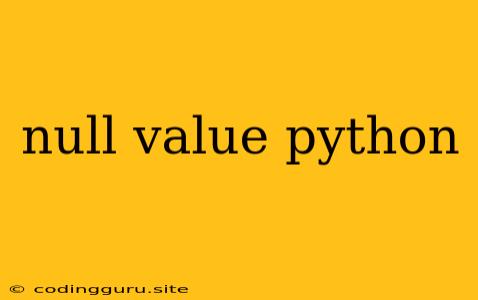Understanding and Handling Null Values in Python
Python, a versatile and widely used programming language, often encounters scenarios where variables might hold no value. These scenarios are represented by the concept of null values in Python, commonly known as None. It's essential to understand how None functions and how to handle it effectively in your code.
What is a Null Value in Python?
In Python, None is a special object representing the absence of a value. It's not the same as 0, an empty string, or an empty list. It signifies that a variable hasn't been assigned any value.
Here are a few scenarios where you might encounter None:
- Function Return Values: Functions can return None if they don't explicitly return another value.
- Uninitialized Variables: Variables declared but not assigned a value will hold None by default.
- Special Cases: Some built-in functions and methods can return None under specific circumstances.
Checking for Null Values
It's crucial to be able to identify None values in your code. You can use the following techniques:
1. Direct Comparison:
if my_variable is None:
print("The variable is None")
2. Using the is Operator:
The is operator checks if two objects are actually the same object in memory. It's more efficient for comparing with None than using ==.
if my_variable is None:
print("The variable is None")
Handling Null Values
Once you've detected a None value, you need to decide how to handle it. Here are some common strategies:
1. Default Values:
Assign a default value if the variable is None.
my_variable = None
if my_variable is None:
my_variable = "Default Value"
2. Error Handling:
Raise an exception if a None value is encountered in a situation where it's unexpected.
def divide(a, b):
if b is None:
raise ValueError("Divisor cannot be None")
return a / b
3. Conditional Logic:
Use conditional statements to execute different code blocks based on whether the variable is None.
my_variable = None
if my_variable is None:
print("Variable is None")
else:
print(f"Variable value: {my_variable}")
4. The or Operator:
Use the or operator to provide a fallback value if the variable is None.
my_variable = None
result = my_variable or "Fallback Value"
print(result)
Examples of Working with Null Values
1. Function Returning None:
def greet(name):
if name is None:
return None
else:
return f"Hello, {name}!"
name = "Alice"
greeting = greet(name)
if greeting is None:
print("Name was not provided.")
else:
print(greeting)
2. Uninitialized Variable:
my_list = []
for i in range(3):
my_variable = None
if my_variable is None:
my_list.append(i * 2)
else:
my_list.append(my_variable)
print(my_list)
Conclusion
Understanding and effectively handling null values in Python is critical for writing robust and reliable code. By learning to identify None values and implementing appropriate handling techniques, you can prevent unexpected errors and ensure your Python programs run smoothly.
